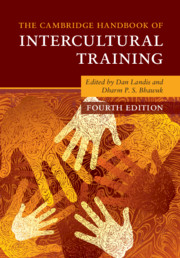Book contents
- The Cambridge Handbook of Intercultural Training
- Reviews
- The Cambridge Handbook of Intercultural Training
- Copyright page
- Dedication
- Frontispiece
- Contents
- Figures
- Tables
- Editors and Contributors
- Foreword
- Preface
- 1 Introduction and Theoretical Framework
- Part I Theoretical Foundations of Intercultural Training
- Part II Practice of Intercultural Training
- Part III Indigenous Psychology and Intercultural Training
- Part IV New Interdisciplinary Approaches to Intercultural Training
- Part V Summing Up
- 25 Intercultural Training for the New Global Village
- Index
- References
25 - Intercultural Training for the New Global Village
Future Research Directions
from Part V - Summing Up
Published online by Cambridge University Press: 18 September 2020
- The Cambridge Handbook of Intercultural Training
- Reviews
- The Cambridge Handbook of Intercultural Training
- Copyright page
- Dedication
- Frontispiece
- Contents
- Figures
- Tables
- Editors and Contributors
- Foreword
- Preface
- 1 Introduction and Theoretical Framework
- Part I Theoretical Foundations of Intercultural Training
- Part II Practice of Intercultural Training
- Part III Indigenous Psychology and Intercultural Training
- Part IV New Interdisciplinary Approaches to Intercultural Training
- Part V Summing Up
- 25 Intercultural Training for the New Global Village
- Index
- References
Summary
In chapter 25, changes taking place in our global village are evaluated and how intercultural research and training can both take a lead role in creating the changes and helping people to effectively work with the changes are discussed. The role of economic development, social changes, and the Internet are discussed. Following this, some of the theoretical and methodological innovations that are on the horizon are discussed. Some of the topics identified from the chapters in the Handbook are presented here, which include culture theories, cultural story-telling, social network analysis (SNA), perception, and emotional contagion. Finally, a number of research issues that are of concern in developing a science of intercultural training that is not only produces results that are repeatable but only account for significant amounts of variance. Many more can be identified and will emerge in the future. It is hoped that researchers and practitioners will use the ideas presented in the chapters of the Handbook, to guide future theory-based research and practice in the field of intercultural training.
Keywords
- Type
- Chapter
- Information
- The Cambridge Handbook of Intercultural Training , pp. 703 - 721Publisher: Cambridge University PressPrint publication year: 2020



